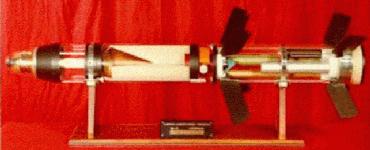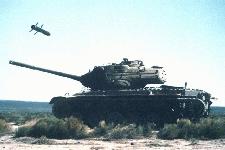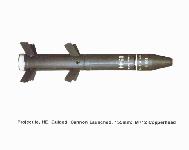


M712 Copperhead
 The M712 Copperhead projectile was the first smart artillery round ever developed. Its accuracy is measured in centimeters, and its lethality is impressive. Copperhead is a cannon-launched, 155mm artillery projectile which guides itself to a laser-designated target. The munition is capable of defeating both armor and point targets at ranges of over six kilometers, and provides the battlefield commander with the unparalleled capability of utilizing artillery to the same effect as direct fire weapons and close air support. The system was employed during Operation Desert Storm, during which it met with great success. Copperhead projectiles were used to destroy observation and border guard posts and forward radar installations during the first week of artillery attacks.
The cannon-launched guided projectile (CLGP) M712 (Copperhead) is a 155-mm, separate-loading,
laser-guided, HE projectile. It is heavier (137.6 pounds) and longer (54 inches) than the standard
155-mm projectile. The M712 projectile consists of three main sections: a guidance section (forward),
warhead section (center), and control section (rear). The guidance section contains the seeker head
assembly and the electronics assembly. The nose of the projectile houses a laser seeker in a plastic
cone. The warhead section contains an HE antitank warhead consisting of 14.75 pounds of
composition B. The control section includes the fins and wings that deploy in flight and allow the
round limited maneuverability.
The trajectory of the Copperhead projectile is similar to that of a conventional round. Only when the projectile
reaches a point on the descending branch of the trajectory does it differ. At that point, on the basis of the two-digit
timer setting included in the fire commands, the guidance and control systems are activated. This enables the
projectile to alter the remainder of its trajectory.
At 20 seconds from impact, the laser designator operator begins designating the target. The
ground laser operator may use a G/VLLD, a laser target designator (LTD), or modular universal laser equipment
(MULE). Airborne systems include the AH-64, OH-58D, and unmanned aerial vehicles. The Copperhead projectile
acquires the reflected laser energy and initiates internal guidance and control, allowing it to maneuver to the target.
The ground surface area in which the round can maneuver is limited. The optimum limits of maneuverability of the
Copperhead round is called a footprint. The size of the footprint is determined by the range and the shape
of the trajectory, but it can also be affected by cloud height. The ballistic aimpoint is usually short of the
target location sent by the laser designator operator. The distance that the ballistic aimpoint is short of the target location
varies and is called the offset correction. This offset distance is used to ensure that the maximum probability of hit occurs
at the original target location sent by the observer. The larger the target location error, the lower the probability of hitting
the target.
The M712 Copperhead projectile was the first smart artillery round ever developed. Its accuracy is measured in centimeters, and its lethality is impressive. Copperhead is a cannon-launched, 155mm artillery projectile which guides itself to a laser-designated target. The munition is capable of defeating both armor and point targets at ranges of over six kilometers, and provides the battlefield commander with the unparalleled capability of utilizing artillery to the same effect as direct fire weapons and close air support. The system was employed during Operation Desert Storm, during which it met with great success. Copperhead projectiles were used to destroy observation and border guard posts and forward radar installations during the first week of artillery attacks.
The cannon-launched guided projectile (CLGP) M712 (Copperhead) is a 155-mm, separate-loading,
laser-guided, HE projectile. It is heavier (137.6 pounds) and longer (54 inches) than the standard
155-mm projectile. The M712 projectile consists of three main sections: a guidance section (forward),
warhead section (center), and control section (rear). The guidance section contains the seeker head
assembly and the electronics assembly. The nose of the projectile houses a laser seeker in a plastic
cone. The warhead section contains an HE antitank warhead consisting of 14.75 pounds of
composition B. The control section includes the fins and wings that deploy in flight and allow the
round limited maneuverability.
The trajectory of the Copperhead projectile is similar to that of a conventional round. Only when the projectile
reaches a point on the descending branch of the trajectory does it differ. At that point, on the basis of the two-digit
timer setting included in the fire commands, the guidance and control systems are activated. This enables the
projectile to alter the remainder of its trajectory.
At 20 seconds from impact, the laser designator operator begins designating the target. The
ground laser operator may use a G/VLLD, a laser target designator (LTD), or modular universal laser equipment
(MULE). Airborne systems include the AH-64, OH-58D, and unmanned aerial vehicles. The Copperhead projectile
acquires the reflected laser energy and initiates internal guidance and control, allowing it to maneuver to the target.
The ground surface area in which the round can maneuver is limited. The optimum limits of maneuverability of the
Copperhead round is called a footprint. The size of the footprint is determined by the range and the shape
of the trajectory, but it can also be affected by cloud height. The ballistic aimpoint is usually short of the
target location sent by the laser designator operator. The distance that the ballistic aimpoint is short of the target location
varies and is called the offset correction. This offset distance is used to ensure that the maximum probability of hit occurs
at the original target location sent by the observer. The larger the target location error, the lower the probability of hitting
the target.


Sources and Resources
http://www.fas.org/man/dod-101/sys/land/m712.htm
Maintained by Robert Sherman
Originally created by John Pike
Updated Thursday, January 21, 1999 7:53:44 PM
 The M712 Copperhead projectile was the first smart artillery round ever developed. Its accuracy is measured in centimeters, and its lethality is impressive. Copperhead is a cannon-launched, 155mm artillery projectile which guides itself to a laser-designated target. The munition is capable of defeating both armor and point targets at ranges of over six kilometers, and provides the battlefield commander with the unparalleled capability of utilizing artillery to the same effect as direct fire weapons and close air support. The system was employed during Operation Desert Storm, during which it met with great success. Copperhead projectiles were used to destroy observation and border guard posts and forward radar installations during the first week of artillery attacks.
The cannon-launched guided projectile (CLGP) M712 (Copperhead) is a 155-mm, separate-loading,
laser-guided, HE projectile. It is heavier (137.6 pounds) and longer (54 inches) than the standard
155-mm projectile. The M712 projectile consists of three main sections: a guidance section (forward),
warhead section (center), and control section (rear). The guidance section contains the seeker head
assembly and the electronics assembly. The nose of the projectile houses a laser seeker in a plastic
cone. The warhead section contains an HE antitank warhead consisting of 14.75 pounds of
composition B. The control section includes the fins and wings that deploy in flight and allow the
round limited maneuverability.
The trajectory of the Copperhead projectile is similar to that of a conventional round. Only when the projectile
reaches a point on the descending branch of the trajectory does it differ. At that point, on the basis of the two-digit
timer setting included in the fire commands, the guidance and control systems are activated. This enables the
projectile to alter the remainder of its trajectory.
At 20 seconds from impact, the laser designator operator begins designating the target. The
ground laser operator may use a G/VLLD, a laser target designator (LTD), or modular universal laser equipment
(MULE). Airborne systems include the AH-64, OH-58D, and unmanned aerial vehicles. The Copperhead projectile
acquires the reflected laser energy and initiates internal guidance and control, allowing it to maneuver to the target.
The ground surface area in which the round can maneuver is limited. The optimum limits of maneuverability of the
Copperhead round is called a footprint. The size of the footprint is determined by the range and the shape
of the trajectory, but it can also be affected by cloud height. The ballistic aimpoint is usually short of the
target location sent by the laser designator operator. The distance that the ballistic aimpoint is short of the target location
varies and is called the offset correction. This offset distance is used to ensure that the maximum probability of hit occurs
at the original target location sent by the observer. The larger the target location error, the lower the probability of hitting
the target.
The M712 Copperhead projectile was the first smart artillery round ever developed. Its accuracy is measured in centimeters, and its lethality is impressive. Copperhead is a cannon-launched, 155mm artillery projectile which guides itself to a laser-designated target. The munition is capable of defeating both armor and point targets at ranges of over six kilometers, and provides the battlefield commander with the unparalleled capability of utilizing artillery to the same effect as direct fire weapons and close air support. The system was employed during Operation Desert Storm, during which it met with great success. Copperhead projectiles were used to destroy observation and border guard posts and forward radar installations during the first week of artillery attacks.
The cannon-launched guided projectile (CLGP) M712 (Copperhead) is a 155-mm, separate-loading,
laser-guided, HE projectile. It is heavier (137.6 pounds) and longer (54 inches) than the standard
155-mm projectile. The M712 projectile consists of three main sections: a guidance section (forward),
warhead section (center), and control section (rear). The guidance section contains the seeker head
assembly and the electronics assembly. The nose of the projectile houses a laser seeker in a plastic
cone. The warhead section contains an HE antitank warhead consisting of 14.75 pounds of
composition B. The control section includes the fins and wings that deploy in flight and allow the
round limited maneuverability.
The trajectory of the Copperhead projectile is similar to that of a conventional round. Only when the projectile
reaches a point on the descending branch of the trajectory does it differ. At that point, on the basis of the two-digit
timer setting included in the fire commands, the guidance and control systems are activated. This enables the
projectile to alter the remainder of its trajectory.
At 20 seconds from impact, the laser designator operator begins designating the target. The
ground laser operator may use a G/VLLD, a laser target designator (LTD), or modular universal laser equipment
(MULE). Airborne systems include the AH-64, OH-58D, and unmanned aerial vehicles. The Copperhead projectile
acquires the reflected laser energy and initiates internal guidance and control, allowing it to maneuver to the target.
The ground surface area in which the round can maneuver is limited. The optimum limits of maneuverability of the
Copperhead round is called a footprint. The size of the footprint is determined by the range and the shape
of the trajectory, but it can also be affected by cloud height. The ballistic aimpoint is usually short of the
target location sent by the laser designator operator. The distance that the ballistic aimpoint is short of the target location
varies and is called the offset correction. This offset distance is used to ensure that the maximum probability of hit occurs
at the original target location sent by the observer. The larger the target location error, the lower the probability of hitting
the target.




